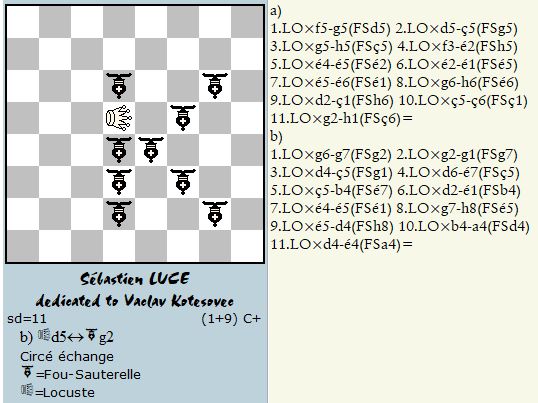|
SDP1 Vaclav Kotesovec, original
(dedicated to Sebastien Luce)
white Lc2
black Gc6d6e6c5d5c4d4d3
sd=44Locust - 8 Grasshoppers PWC C+
1.Lc2*d3-e4[+bGc2] 2.Le4*c2-b1[+bGe4] 3.Lb1*e4-f5[+bGb1] 4.Lf5*e6-d7[+bGf5]{
} 5.Ld7*c6-b5[+bGd7] 6.Lb5*c4-d3[+bGb5] 7.Ld3*f5-g6[+bGd3] 8.Lg6*d6-c6[+bGg6]{
} 9.Lc6*c5-c4[+bGc6] 10.Lc4*d4-e4[+bGc4] 11.Le4*d3-c2[+bGe4] 12.Lc2*c4-c5[+bGc2]{
} 13.Lc5*d5-e5[+bGc5] 14.Le5*e4-e3[+bGe5] 15.Le3*e5-e6[+bGe3] 16.Le6*e3-e2[+bGe6]{
} 17.Le2*c2-b2[+bGe2] 18.Lb2*b5-b6[+bGb2] 19.Lb6*c6-d6[+bGb6] 20.Ld6*e6-f6[+bGd6]{
} 21.Lf6*d6-c6[+bGf6] 22.Lc6*c5-c4[+bGc6] 23.Lc4*c6-c7[+bGc4] 24.Lc7*d7-e7[+bGc7]{
} 25.Le7*c7-b7[+bGe7] 26.Lb7*e7-f7[+bGb7] 27.Lf7*b7-a7[+bGf7] 28.La7*b6-c5[+bGa7]{
} 29.Lc5*c4-c3[+bGc5] 30.Lc3*f6-g7[+bGc3] 31.Lg7*f7-e7[+bGg7] 32.Le7*c5-b4[+bGe7]{
} 33.Lb4*c3-d2[+bGb4] 34.Ld2*e2-f2[+bGd2] 35.Lf2*d2-c2[+bGf2] 36.Lc2*b2-a2[+bGc2]{
} 37.La2*a7-a8[+bGa2] 38.La8*a2-a1[+bGa8] 39.La1*b1-c1[+bGa1] 40.Lc1*c2-c3[+bGc1]{
} 41.Lc3*g7-h8[+bGc3] 42.Lh8*c3-b2[+bGh8] 43.Lb2*b4-b5[+bGb2] 44.Lb5*b2-b1[+bGb5] {=}
Absolute length record with this material. |
|
SDP2 Vaclav Kotesovec, original
white Lc1
black Gd6c5c4d4d3e3c2f2
sd=38Locust - 8 Grasshoppers PWC C+
1.Lc1*c2-c3[+bGc1] 2.Lc3*d4-e5[+bGc3] 3.Le5*e3-e2[+bGe5] 4.Le2*f2-g2[+bGe2]{
} 5.Lg2*e2-d2[+bGg2] 6.Ld2*d3-d4[+bGd2] 7.Ld4*d6-d7[+bGd4] 8.Ld7*d4-d3[+bGd7]{
} 9.Ld3*c3-b3[+bGd3] 10.Lb3*c4-d5[+bGb3] 11.Ld5*c5-b5[+bGd5] 12.Lb5*b3-b2[+bGb5]{
} 13.Lb2*d2-e2[+bGb2] 14.Le2*d3-c4[+bGe2] 15.Lc4*d5-e6[+bGc4] 16.Le6*e5-e4[+bGe6]{
} 17.Le4*e6-e7[+bGe4] 18.Le7*d7-c7[+bGe7] 19.Lc7*e7-f7[+bGc7] 20.Lf7*c7-b7[+bGf7]{
} 21.Lb7*b5-b4[+bGb7] 22.Lb4*c4-d4[+bGb4] 23.Ld4*e4-f4[+bGd4] 24.Lf4*d4-c4[+bGf4]{
} 25.Lc4*f4-g4[+bGc4] 26.Lg4*e2-d1[+bGg4] 27.Ld1*c1-b1[+bGd1] 28.Lb1*b2-b3[+bGb1]{
} 29.Lb3*b4-b5[+bGb3] 30.Lb5*b7-b8[+bGb5] 31.Lb8*b5-b4[+bGb8] 32.Lb4*c4-d4[+bGb4]{
} 33.Ld4*g4-h4[+bGd4] 34.Lh4*d4-c4[+bGh4] 35.Lc4*b4-a4[+bGc4] 36.La4*b3-c2[+bGa4]{
} 37.Lc2*c4-c5[+bGc2] 38.Lc5*c2-c1[+bGc5] {=}
This problem is not a length record, but contains a switchback of locust. |
|
SDP3 Vaclav Kotesovec, original
white LRd4
black Gd6c5d5e5f5e4d3
sd=46Rook-Locust - 7 Grasshoppers PWC C+
1.LRd4*e4-f4[+bGd4] 2.LRf4*d4-c4[+bGf4] 3.LRc4*c5-c6[+bGc4] 4.LRc6*d6-e6[+bGc6]{
} 5.LRe6*e5-e4[+bGe6] 6.LRe4*e6-e7[+bGe4] 7.LRe7*e4-e3[+bGe7] 8.LRe3*d3-c3[+bGe3]{
} 9.LRc3*c4-c5[+bGc3] 10.LRc5*d5-e5[+bGc5] 11.LRe5*f5-g5[+bGe5] 12.LRg5*e5-d5[+bGg5]{
} 13.LRd5*c5-b5[+bGd5] 14.LRb5*d5-e5[+bGb5] 15.LRe5*e3-e2[+bGe5] 16.LRe2*e5-e6[+bGe2]{
} 17.LRe6*c6-b6[+bGe6] 18.LRb6*b5-b4[+bGb6] 19.LRb4*f4-g4[+bGb4] 20.LRg4*g5-g6[+bGg4]{
} 21.LRg6*e6-d6[+bGg6] 22.LRd6*g6-h6[+bGd6] 23.LRh6*d6-c6[+bGh6] 24.LRc6*c3-c2[+bGc6]{
} 25.LRc2*c6-c7[+bGc2] 26.LRc7*e7-f7[+bGc7] 27.LRf7*c7-b7[+bGf7] 28.LRb7*b6-b5[+bGb7]{
} 29.LRb5*b4-b3[+bGb5] 30.LRb3*b5-b6[+bGb3] 31.LRb6*b7-b8[+bGb6] 32.LRb8*b6-b5[+bGb8]{
} 33.LRb5*b3-b2[+bGb5] 34.LRb2*c2-d2[+bGb2] 35.LRd2*e2-f2[+bGd2] 36.LRf2*d2-c2[+bGf2]{
} 37.LRc2*b2-a2[+bGc2] 38.LRa2*c2-d2[+bGa2] 39.LRd2*f2-g2[+bGd2] 40.LRg2*d2-c2[+bGg2]{
} 41.LRc2*g2-h2[+bGc2] 42.LRh2*h6-h7[+bGh2] 43.LRh7*h2-h1[+bGh7] 44.LRh1*h7-h8[+bGh1]{
} 45.LRh8*b8-a8[+bGh8] 46.LRa8*a2-a1[+bGa8] {=}
|
|
HP1 Vaclav Kotesovec, original
white Lb1
black Gh7g6a5g4a2h2
h=18Locust - 6 Grasshoppers PWC C+
1.Gh7-h1 Lb1*g6-h7[+bGb1] 2.Gh1-a1 Lh7*h2-h1[+bGh7] 3.Ga1-a3 Lh1*b1-a1[+bGh1]{
} 4.Ga3*a1[+wLa3] La3*a5-a6[+bGa3] 5.Ga3-a7 La6*a7-a8[+bGa6] 6.Gh1-h8 La8*a6-a5[+bGa8]{
} 7.Ga2-a6 La5*a6-a7[+bGa5] 8.Gh8-h6 La7*a5-a4[+bGa7] 9.Ga1-a5 La4*a5-a6[+bGa4]{
} 10.Gh7-h5 La6*a4-a3[+bGa6] 11.Gh5-f3 La3*f3-g3[+bGa3] 12.Ga3-h3 Lg3*g4-g5[+bGg3]{
} 13.Gh3-h7 Lg5*g3-g2[+bGg5] 14.Ga8-h1 Lg2*g5-g6[+bGg2] 15.Gh1-f3 Lg6*g2-g1[+bGg6]{
} 16.Gh6-f6 Lg1*g6-g7[+bGg1] 17.Ga6-g6 Lg7*f6-e5[+bGg7] 18.Gg6-g8 Le5*g7-h8[+bGe5] {=}
|
|
HP2 Vaclav Kotesovec, original
white Lc2
black Ga6a7c7b8d8e8f8g8
h=200.1.1... Locust - 8 Grasshoppers PWC C+
1...Lc2*c7-c8[+bGc2] 2.Gf8-h8 Lc8*b8-a8[+bGc8] 3.Gd8-f8 La8*c8-d8[+bGa8]{
} 4.Ge8-c8 Ld8*c8-b8[+bGd8] 5.Ga7-a5 Lb8*d8-e8[+bGb8] 6.Gf8-d8 Le8*d8-c8[+bGe8]{
} 7.Ga6-a4 Lc8*e8-f8[+bGc8] 8.Gg8-e8 Lf8*e8-d8[+bGf8] 9.Ga4-d1 Ld8*f8-g8[+bGd8]{
} 10.Gd1-b3 Lg8*b3-a2[+bGg8] 11.Gc8-c1 La2*c2-d2[+bGa2] 12.Gc1-e3 Ld2*e3-f4[+bGd2]{
} 13.Gb8-g3 Lf4*g3-h2[+bGf4] 14.Ga8-e8 Lh2*f4-e5[+bGh2] 15.Gh8-d4 Le5*d4-c3[+bGe5]{
} 16.Gd8-d1 Lc3*d2-e1[+bGc3] 17.Ga5-f5 Le1*e5-e6[+bGe1] 18.Ge8-e5 Le6*e5-e4[+bGe6]{
} 19.Ge1-b4 Le4*e6-e7[+bGe4] 20.Ge4-a4 Le7*b4-a3[+bGe7] {=}
|
|
HP3 Vaclav Kotesovec, original
white LRd1
black Gf8g7b1
h=200.1.1... Rook-Locust - 3 Grasshoppers PWC C+
1...LRd1*b1-a1[+bGd1] 2.Gf8-h6 LRa1*d1-e1[+bGa1] 3.Ga1-f1 LRe1*f1-g1[+bGe1]{
} 4.Gh6-f8 LRg1*e1-d1[+bGg1] 5.Gg1-c1 LRd1*c1-b1[+bGd1] 6.Gf8-h6 LRb1*d1-e1[+bGb1]{
} 7.Gh6-f8 LRe1*b1-a1[+bGe1] 8.Gf8-h6 LRa1*e1-f1[+bGa1] 9.Ga1-g1 LRf1*g1-h1[+bGf1]{
} 10.Gh6-f8 LRh1*f1-e1[+bGh1] 11.Gh1-d1 LRe1*d1-c1[+bGe1] 12.Gf8-h6 LRc1*e1-f1[+bGc1]{
} 13.Gh6-f8 LRf1*c1-b1[+bGf1] 14.Gf8-h6 LRb1*f1-g1[+bGb1] 15.Gh6-f8 LRg1*b1-a1[+bGg1]{
} 16.Gf8-h6 LRa1*g1-h1[+bGa1] 17.Ga1-h8 LRh1*h6-h7[+bGh1] 18.Gh8-f6 LRh7*g7-f7[+bGh7]{
} 19.Gh7-e7 LRf7*f6-f5[+bGf7] 20.Ge7-g7 LRf5*f7-f8[+bGf5] {=}
|
|
HP4 Vaclav Kotesovec, original
white LRa1
black Gb1c1g4a6h6a7f7d8
h=23Rook-Locust - 8 Grasshoppers PWC C+
1.Ga7-g7 LRa1*a6-a7[+bGa1] 2.Gg7-g3 LRa7*f7-g7[+bGa7] 3.Gg4-g8 LRg7*g3-g2[+bGg7]{
} 4.Gg8-c8 LRg2*g7-g8[+bGg2] 5.Gd8-h8 LRg8*c8-b8[+bGg8] 6.Gh8-h5 LRb8*g8-h8[+bGb8]{
} 7.Gb1-d1 LRh8*b8-a8[+bGh8] 8.Gc1-e1 LRa8*a7-a6[+bGa8] 9.Ga8-a5 LRa6*a5-a4[+bGa6]{
} 10.Gd1-f1 LRa4*a6-a7[+bGa4] 11.Ge1-g1 LRa7*a4-a3[+bGa7] 12.Gf1-h1 LRa3*a7-a8[+bGa3]{
} 13.Gh1-f3 LRa8*a3-a2[+bGa8] 14.Gh5-e2 LRa2*e2-f2[+bGa2] 15.Gg2-e4 LRf2*f3-f4[+bGf2]{
} 16.Gg1-e3 LRf4*e4-d4[+bGf4] 17.Gf2-f5 LRd4*f4-g4[+bGd4] 18.Gh8-c3 LRg4*d4-c4[+bGg4]{
} 19.Gg4-e6 LRc4*c3-c2[+bGc4] 20.Gh6-d6 LRc2*c4-c5[+bGc2] 21.Ga2-f7 LRc5*f5-g5[+bGc5]{
} 22.Ge6-g8 LRg5*c5-b5[+bGg5] 23.Gg8-g4 LRb5*g5-h5[+bGb5] {=}
C+, Alybadix 3 hours 45 minutes |
|
HP5 Vaclav Kotesovec, original
white LBd3
black Ga5e5g1
h=23Bishop-Locust - 3 Grasshoppers PWC C+
1.Ga5-f5 LBd3*f5-g6[+bGd3] 2.Gg1-g7 LBg6*d3-c2[+bGg6] 3.Gg7-g5 LBc2*g6-h7[+bGc2]{
} 4.Gg5-d5 LBh7*c2-b1[+bGh7] 5.Gd5-f5 LBb1*f5-g6[+bGb1] 6.Gh7-f5 LBg6*f5-e4[+bGg6]{
} 7.Ge5-e3 LBe4*g6-h7[+bGe4] 8.Ge3-e5 LBh7*e4-d3[+bGh7] 9.Gb1-e4 LBd3*e4-f5[+bGd3]{
} 10.Ge5-g5 LBf5*d3-c2[+bGf5] 11.Gg5-e5 LBc2*f5-g6[+bGc2] 12.Gh7-f5 LBg6*f5-e4[+bGg6]{
} 13.Ge5-e3 LBe4*c2-b1[+bGe4] 14.Ge3-e5 LBb1*e4-f5[+bGb1] 15.Gg6-e4 LBf5*e4-d3[+bGf5]{
} 16.Ge5-g5 LBd3*f5-g6[+bGd3] 17.Gg5-g7 LBg6*d3-c2[+bGg6] 18.Gb1-d3 LBc2*d3-e4[+bGc2]{
} 19.Gg7-g5 LBe4*c2-b1[+bGe4] 20.Gg6-g4 LBb1*e4-f5[+bGb1] 21.Gg5-e5 LBf5*g4-h3[+bGf5]{
} 22.Ge5-g5 LBh3*f5-e6[+bGh3] 23.Gh3-d7 LBe6*d7-c8[+bGe6] {=}
|
|
HP6 Vaclav Kotesovec, original
white LBc8
black Ga5b1b8f6f7h4h5h7
h=35Bishop-Locust - 8 Grasshoppers PWC C+
1.Gf7-f5 LBc8*f5-g4[+bGc8] 2.Gh5-f3 LBg4*f3-e2[+bGg4] 3.Gh4-f4 LBe2*g4-h5[+bGe2]{
} 4.Gc8-a8 LBh5*e2-d1[+bGh5] 5.Gf6-f3 LBd1*f3-g4[+bGd1] 6.Gh5-f3 LBg4*f3-e2[+bGg4]{
} 7.Ga8-a4 LBe2*g4-h5[+bGe2] 8.Ga4-g4 LBh5*g4-f3[+bGh5] 9.Gd1-a1 LBf3*e2-d1[+bGf3]{
} 10.Gf4-f2 LBd1*f3-g4[+bGd1] 11.Gh5-f3 LBg4*f3-e2[+bGg4] 12.Gb1-e1 LBe2*g4-h5[+bGe2]{
} 13.Gd1-f1 LBh5*e2-d1[+bGh5] 14.Gf1-f3 LBd1*f3-g4[+bGd1] 15.Gh5-f3 LBg4*f3-e2[+bGg4]{
} 16.Gd1-f1 LBe2*g4-h5[+bGe2] 17.Ge1-e3 LBh5*e2-d1[+bGh5] 18.Gf1-f3 LBd1*f3-g4[+bGd1]{
} 19.Gh5-f3 LBg4*f3-e2[+bGg4] 20.Gf2-d2 LBe2*g4-h5[+bGe2] 21.Gd1-d3 LBh5*e2-d1[+bGh5]{
} 22.Gd3-f3 LBd1*f3-g4[+bGd1] 23.Gh5-f3 LBg4*f3-e2[+bGg4] 24.Gd1-d3 LBe2*d3-c4[+bGe2]{
} 25.Ge2-b5 LBc4*b5-a6[+bGc4] 26.Ga5-a7 LBa6*c4-d3[+bGa6] 27.Ga6-e2 LBd3*e2-f1[+bGd3]{
} 28.Ga1-a8 LBf1*d3-c4[+bGf1] 29.Gf1-b5 LBc4*b5-a6[+bGc4] 30.Ga7-f2 LBa6*c4-d3[+bGa6]{
} 31.Gf2-c2 LBd3*c2-b1[+bGd3] 32.Ge3-c3 LBb1*d3-e4[+bGb1] 33.Ga8-f3 LBe4*f3-g2[+bGe4]{
} 34.Gd2-h2 LBg2*e4-d5[+bGg2] 35.Gh2-f2 LBd5*g2-h1[+bGd5] {=}
Length record. |
